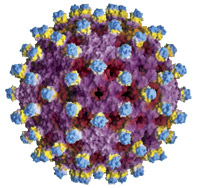HIV
Coinfection Has Little Effect on Response to Chronic Hepatitis B Treatment
By
Liz Highleyman Hepatitis
B Virus |
 |
| HIV
Virus |
Antiviral
therapy for chronic hepatitis B virus (HBV) infection
is similarly effective in HIV negative and HIV positive
patients, according to a study published in the April
2009 issue of Hepatology. Studies
have consistently shown that HIV-HCV
coinfected patients do not respond as well to interferon-based
therapy as those with HCV monoinfection. While
interferon stimulates the natural immune response, and therefore its effectiveness
may be impaired by HIV-related immune deficiency, antiviral therapy for HBV directly
targets the virus. Furthermore, some nucleoside/nucleotide reverse transcriptase
inhibitors (NRTIs) -- including lamivudine
(3TC, Epivir), emtricitabine (Emtriva),
and tenofovir (Viread, also in the
Truvada and Atripla
combination pills) -- have dual activity against both HBV and HIV.
After
starting antiviral treatment for hepatitis B, there is a biphasic clearance of
HBV, similar to that seen with HIV and HCV therapy, Sharon Lewin from Alfred Hospital
in Melbourne, Australia, and colleagues noted as background. However, little is
known about the effect of combination NRTIs and the influence of HIV coinfection
on HBV viral kinetics following the initiation of dually active HAART.
In
the current study, 21 treatment-naive HIV-HBV coinfected patients in Thailand
were enrolled in a viral kinetics sub-study of the TICO (Tenofovir in HIV-1-HBV
Coinfection) study, a randomized trial comparing 300 mg tenofovir versus 300 mg
lamivudine versus tenofovir plus lamivudine, as part of an efavirenz
(Sustiva)-based HAART regimen.
The
researchers measured HBV DNA frequently over the first 56 days of treatment. To
fit the viral load data, they used a model of HBV kinetics that allows for the
estimation of treatment effectiveness, viral clearance, and infected cell loss.
Results  | A
biphasic decline in HBV DNA was observed in almost all patients. |  | There
were no significant differences in HBV viral dynamic parameters between the 3
treatments groups. |  | Overall
HBV treatment effectiveness was 98%. |  | The
median HBV virion (single virus particle) half-life was 1.2 days. |  | The
median half-life of an HBV-infected cell was 7.9 days. |  | Hepatitis
B "e" antigen (HBeAg) positive individuals had a significantly longer
infected-cell half-life than HBeAg negative patients (9.0 vs 6.2 days; P = 0.02).
|
"HBV
viral dynamic parameters are similar following anti-HBV NRTI monotherapy and dual
combination therapy in the setting of HIV-1-HBV coinfection," the study authors
concluded. "HIV-1 coinfection has minimal effect on HBV viral dynamics, even
in the setting of advanced HIV-1-related immunosuppression."
Infectious
Diseases Unit, Alfred Hospital, Melbourne, Australia; Monash University, Melbourne,
Australia; Los Alamos National Laboratory, Los Alamos, NM; HIV Netherlands Australia
Thailand Research Collaboration, Thai Red Cross Bangkok, Thailand; Victorian Infectious
Diseases Reference Laboratory, Melbourne, Australia; National Centre in HIV Epidemiology
and Clinical Research, University of New South Wales, Sydney, Australia; Chulalongkorn
University, Bangkok, Thailand. 6/16/09 Reference
SR
Lewin, RM Ribeiro, A Avihingsanon, and others. Viral dynamics of hepatitis B virus
DNA in human immunodeficiency virus-1-hepatitis B virus coinfected individuals:
Similar effectiveness of lamivudine, tenofovir, or combination therapy. Hepatology
49(4): 1113-1121. April 2009.
|